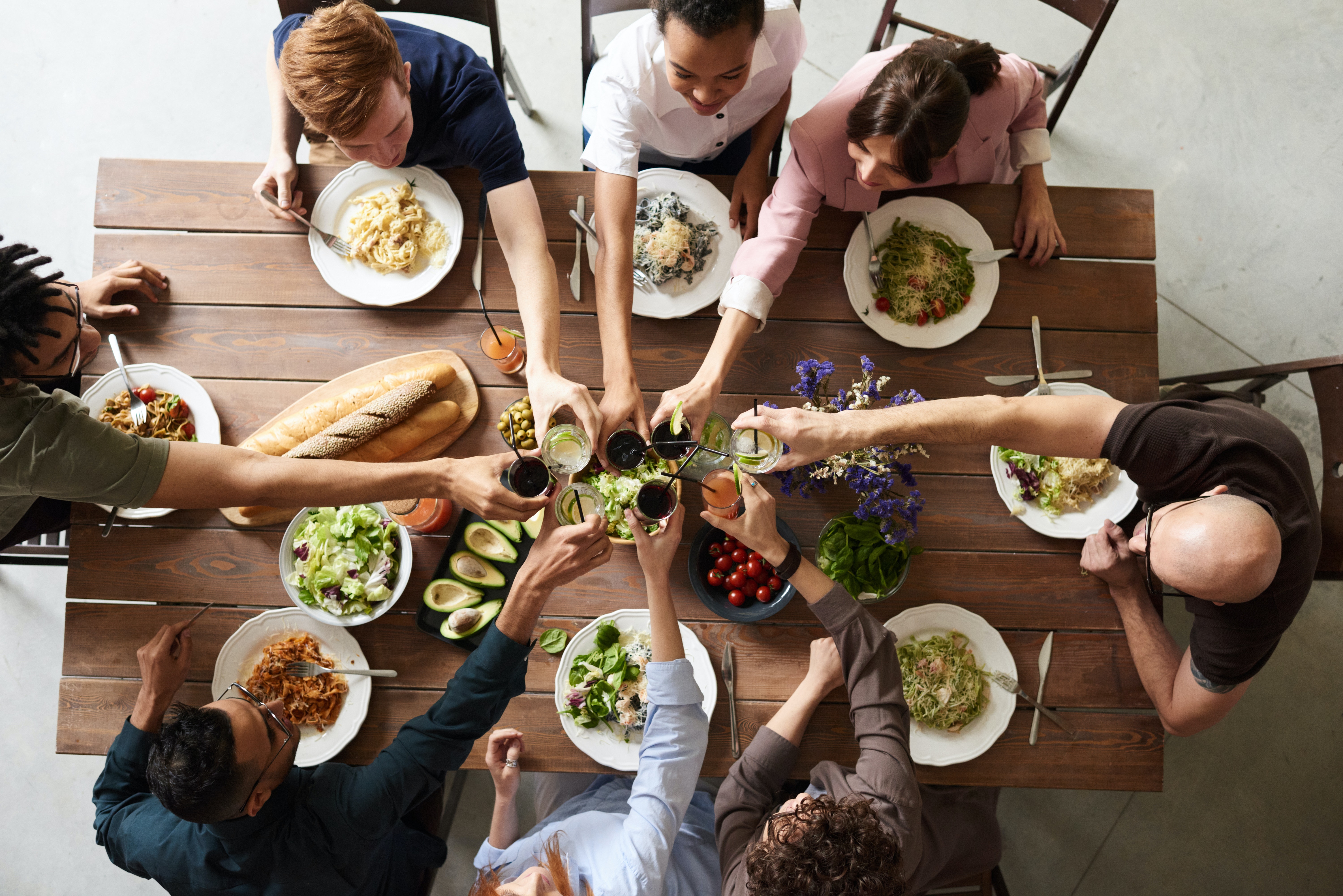
To live a long and sound life, one should have some knowledge of dietetics, dietary restrictions concerning poisoning and incompatibility, and moderation in the quantity of food intake. Overeating, under-nourishment, and inadequate diet cause illness and shorten life-span. There are two aspects - knowledge of food and knowledge of drink.
All food products are divided into five categories: grains, meat oils and fats, aromatic herbs or vegetables, and assorted cooked dishes.
Grains include those which develop bristling awns and those which are leguminous or podded. The former include rice, millet, Chinese buckwheat, wheat and barley, and the latter comprise peas, Himalayan beans and red beans, Chinese broad beans, and lentils. Grains are supplemented by sesame, linseed and Polygonum.
In general, grains with bristling awns are of cool nature, nutritious, conducive to virility, and capable of curing disorders of wind and of producing an excessive imbalance of phlegm. Rice, mild and light in potency, helps against diarrhoea and vomiting. Millet, heavy in potency, helps to heal wounds and fractured bones. Common barley replenishes physical vigour and increases the number of faeces.
Peas and Himalayan beans among leguminous grains are light and cooling in nature. They help to stop bleeding and vomiting and cure disorders of phlegm combined with fever. Chinese broad beans are a remedy for coughing, dyspnea or breathlessness, haemorrhoids, and seminal lithiasis. They increase blood and bile. Himalayan beans cure diseases of wind, increasing the power of phlegm, bile and semen. Lentil is helpful against erysipelas, podagra, and blood disorders.
Black and white sesame seeds are heavy and warming, hence they increase virility, and cure diseases of wind. Linseed is bitter-sweet, oily and helpful for disorders of wind. All varieties of buckwheat are cool, light, and capable of curing wounds, but increase all the three humors.
Meat. Animals are divided into eight groups: gallinaceous birds which dig for food with their claws; birds which dig for food with their beaks; small game animals; big-game animals; predatory wild beasts, birds of prey; domestic animals which are actually a supplement to the eight groups; underground animals; and aquatic creatures. The first three groups of animals inhabit dry areas, while the last two live in dampness, and the others may dwell anywhere. The meat of animals from dry areas is cooling and owing to its light and rough potency reduces heat in conjunction with the disorders of wind and phlegm. The meat of creatures from damp or wet regions is oily, heavy and warm. It is helpful against disorders of the stomach, lumbar region, and cold disorders of wind. The meat of animals who live in zones which are both dry and damp possess both warm and cold potencies.
Mutton, for example, is oily, warm, and therefore easily digested. It increases physical vigour, helps against disorders of wind and phlegm and stimulates the appetite. Goat meat is heavy and cool helps against venereal diseases, smallpox, and burns. Beef is oily and cool and it, therefore, reduces the heat in conjunction with disorders of wind. The meat of the horse - Asiatic wild ass donkey and mule interrupts festering sores and alleviates cold diseases of the kidneys and diseases of serum. Pork is cooling, light and a remedy for ulcers. Buffalo meat improves sleep and produces muscle tissue. Yak meat is oily, warm, relieves cold disorders, and increases blood and bile. Poultry and sparrow flesh increases the amount of semen while healing ulcers and wounds. Peacock flesh cures eye diseases and loss of voice, while cheese stimulates the appetite, produces dry faeces, and alleviates disorders of phlegm. The buttery sediment or residue from a milk churn counteracts disorders of phlegm and wind.
Oil. Sesame oil is sharp and warm in nature. It cures leanness and obesity, as well as healing disorders of phlegm and wind. Mustard oil depresses wind and generates phlegm and bile. Bone marrow also depresses wind, while invigorating semen and producing phlegm. Fat counteracts ailments of the bones and joints, as well as burns - disorders of wind and diseases of the brain, ears and womb.
By constantly consuming various oils, digestion is stimulated, the internal humors are cleansed, the complexion is improved, physical vigour and the senses are strengthened and the lifespan may be prolonged up to one hundred years.
Aromatic herbs and vegetables may grow either in dry or damp places. In the first case they are light and warm in their potencies. In the second case, they are heavy and cool. According to these characteristics, they are used to counteract diseases of cold or heat. Vegetables and herbs may be consumed raw or cooked. Onion improves sleep, stimulates the appetite and cures disorders of phlegm and wind. Garlic is heavy and cool. It counteracts diseases of animalcules and heat in association with wind. New radish is light and warm, improving digestion. Old radish which is heavy and cool produces phlegm. New and old turnips act respectively in the same way and also protect against poisoning. Rhubarb leaves stimulate the appetite and cure disorders of phlegm. It should be remembered that all greens cause obstruction of the channels and suppress the potencies of medicines.
Assorted Cooked Dishes benefit those who are thirsty or emaciated, while improving digestion, bringing the bodily constituents into balance and softening the channels. Rice dishes are particularly nutritious. Patients are recommended to eat boiled rice, starting with thin gruel and gradually changing to thicker puddings and porridges until dry boiled rice can be digested. Rice puddings increase heat but also alleviate constipation. Thick rice porridge increases the appetite, stops diarrhoea and relieves thirst. Savoury rice, which is boiled with peppers and other spices is easily assimilated, but difficult to digest if boiled in milk or meat broth. Parched rice stops diarrhoea and helps fractured bones to mend. Immature grain soup alleviates constipation. Cold barley dough however difficult to assimilate strengthens the body. Cooked barley is of course lighter and easier to digest.
Recommends that one adhere to a diet that is appropriate to the season of the year.
• In early winter one must eat a lot of foods with the tastes of sweet, sour, and salty. One also should eat meat soup, oily foods, butter and fatty meat.
• In the spring (late winter) one should eat foods having the tastes of bitter, hot, and astringent such as old barley, roasted meat of land animals living in dry places (goat meat), honey, boiled water (at room temperature), and ginger decoction.
• In early summer eat sweet, light, oily and cool foods (pork). Avoid salty, hot tasting, and sour foods. Only drink alcohol when mixed with cool water or watered down with ice.
• In the monsoon (late summer), eat sweet, salty, and bitter foods as in early winter, as well as foods that are light, warm and oily.
• In the monsoon and winter, take foods that are warm, in spring use rough foods.In early summer and fall, eat cool foods.
All the seasonal recommendations would be adjusted depending on the person’s humoral makeup and variations in the particular season. If one is young, in good health, with good digestion, then one should be able to eat improperly once and a while. Food in general should be eaten cooked and warm. Most foods should be eaten fresh. Leftover foods are considered stale after 24 hours, even if refrigerated.
Once you’ve sorted out the best diet for your overall health, consider booking an acupuncture appointment at AB Acupuncture. A holistic approach to Eastern medicine is a great way to incorporate these healing ideas in all aspects of your life.

When hearing the name Ginger, some people might think of Ginger Rogers. Others, such as myself, might think of Ginger from Gilligan's Island. At the same time, there also exists the historically important herb which is also named Ginger. It is this last Ginger which will be the topic of this featured article.
When I first began my Ginger research, I naturally checked to see if one of my favorite published Internet herbalists had anything to say about this pungent herb. As it turns out, Steven Foster does have an article on his website regarding Ginger. On his website, I discovered that his mother and my mother share a common home remedy for an upset stomach. This home remedy is Ginger Ale. For me, Ginger Ale was accompanied by Saltine Crackers. Interestingly, among many of the things I learned at his website and other websites as well, it turns out that there is a basis in fact for Dr. Mom’s prescription.
First, let's look at what Ginger is, and where it comes from. The botanical name for the plant that Ginger comes from is Zingiber Officinale and the part of the plant typically used is the fresh or dried roots. The Ginger family consists of "1200 plant species in 53 genera" while the name of the genus "Zingiber includes about 85 species of aromatic herbs from East Asia and tropical Australia."1 Botanical.com A Modern Herbal by Mrs. M Grieve has an excellent description of the plant: The description is as follows: "Ginger is a perennial root which creeps and increases underground, in tuberous joints; in the spring it sends up from its roots a green reed, like a stalk, 2 feet high, with narrow lanceolate leaves; these die down annually. The flowering stalk rises directly from the root, ending in an oblong scallop spike; from each spike, a white or yellow bloom grows." Important world producers of Ginger include; "Fiji, India, Jamaica, Nigeria, Sierra Leone, and China. American imports come from China, several Caribbean Islands, Africa, Central America, Brazil, and Australia."
While Ginger is one of the world's most famous spices and we put it into all sorts of foods such as ales, beers, cakes, cookies, and meat dishes, its exact origin is unknown. Herbal researcher and historian Richard Lucas notes that "Ginger holds a high place in Chinese materia medica." Foster notes that Ginger is mentioned in the earliest of Chinese herbals dating as far back as 2000 B.C. When considering Ginger's historical use in China and India, Foster makes an important distinction that fresh and dried Ginger have historically had different medicinal qualities.
Some of the various uses in TCM for Ginger include; "abdominal bloating, coughing, vomiting, diarrhea, and rheumatism." In Ayurvedic medicine also, Ginger has been used "for the treatment of inflammatory joint diseases, such as arthritis."
To bring us up to date regarding Ginger in modern China, it may help to see the following quote by Foster:
"Even in modern China, while an essential ingredient in almost any meal, it is also one of the most widely consumed drugs. Both fresh and dried roots are official drugs of the modern Chinese pharmacopeia, as is a liquid extract and tincture of ginger. Ginger is used in dozens of traditional Chinese prescriptions as a "guide drug" to "mediate" the effects of potentially toxic ingredients. In fact, in modern China, Ginger is believed to be used in half of all herbal prescriptions."
Historically, it is known that Ginger found its way to western civilization as early as the 2nd century A.D. Its popularity as a spice in the western world has grown ever since. Furthermore, in England, by the 13th and 14th century Ginger was the most popular spice next to Pepper. This is despite the fact that it was a very expensive spice, costing as much as one sheep per pound! Going forward in time, Ginger has remained a popular spice and medicinal herb. Demand continues to increase as the herb rises in popularity.
The chemistry of Ginger is also quite fascinating. There are two distinct groups of chemicals responsible for the sensory perception of Ginger in the mouth and the nose. It is a mixture of terpenoids within the volatile oils that impart the characteristic aroma and modifies the taste. Meanwhile, it is "the non-volatile pungent principles, such as the gingerols and zingerone which produce the "hot" sensation in the mouth."
While the research is not conclusive, modern studies have indicated that Ginger is effective against nausea and perhaps even more effective than Dramamine with regard to nausea associated with motion sickness. Another recent study, adding to ginger's reputation as a stomach, reflects that "acetone and methanol extracts of ginger strongly inhibit gastric ulceration."
Concerning the possible dangers of using Ginger, it is generally recommended that pregnant women and people with gallbladder complications should avoid this herb.
In conclusion, as people develop their taste for Ginger and realize its medicinal value and modern research continues to validate the medicinal claims, it is likely that it will continue to grow in popularity. Additionally, it is hoped that yet another herb is on the horizon, which will yield medicinal promise, together with medicinal herbs, eastern medicine also likes to add acupuncture to help with diseases and improve our immune system, alternative therapy is highly recommended together with alternative medicine.
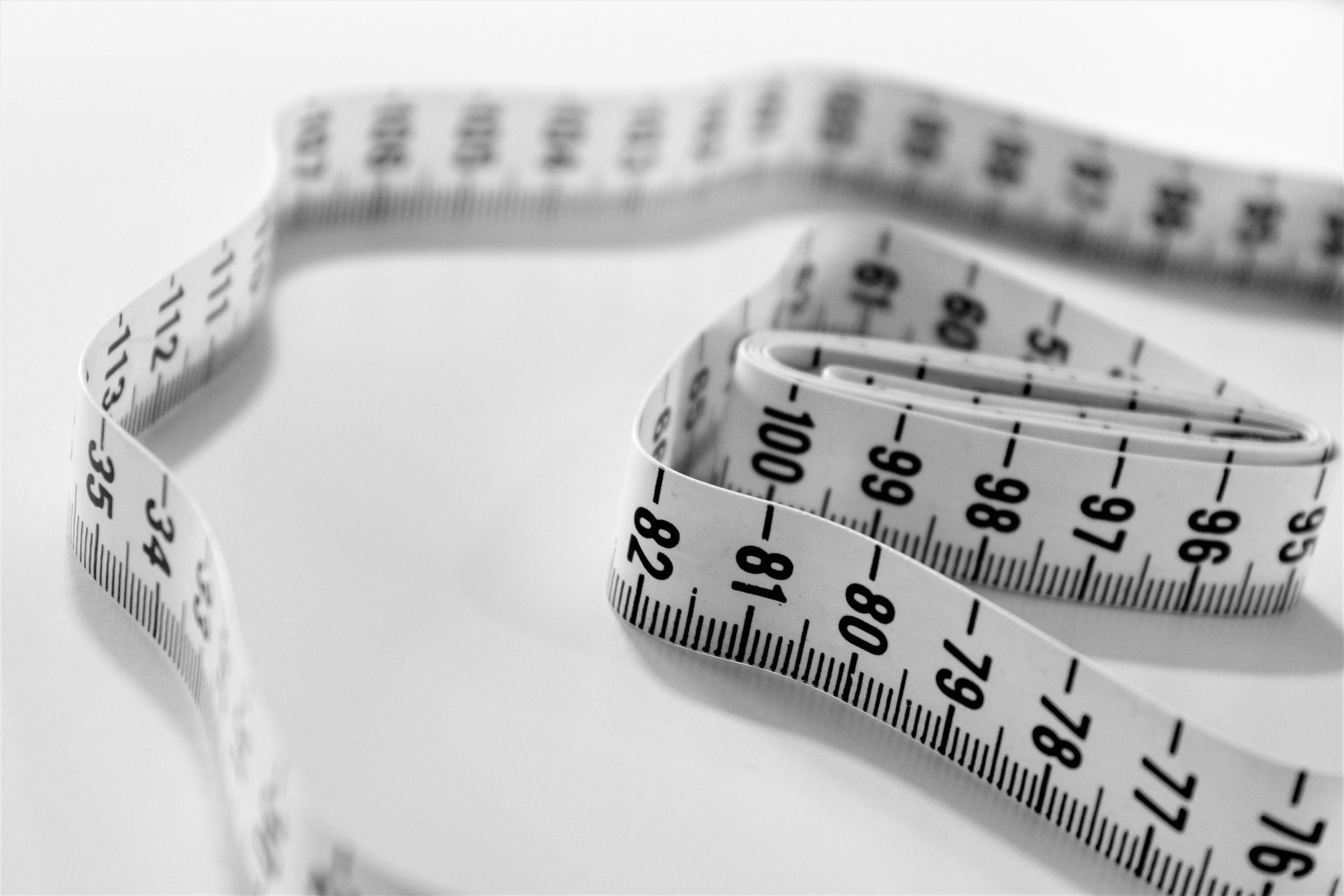
"I am so confused. Every time I watch TV or read the newspaper, I hear some new cause of obesity. Is it inherited? Is it caused by too many fast-food ads and too many opportunities to be sedentary? Or is it the result of brain chemistry that causes food addiction?
"I mean, we have been working with a really great nutritionist and exercise person to create a healthier lifestyle for our entire family. We all have lost some weight and feel better but it scares me that our actions won't cure our 14-year-old son, that maybe Bobby just inherited a tendency to be overweight from my wife and me and is stuck with it. And frankly, I don't even understand how someone could be 'addicted' to food."
Mr. S. was visibly agitated as he spoke to fellow members of the support group for parents of overweight kids. He held in his hand a national magazine, the cover of which posed the question "The Weight Debate: Is Obesity Really a Disease?" The magazine had some great information in it, but nothing definitive about an exact cause or guaranteed treatment for weight problems.
Scientists have known for a long time that children of significantly overweight parents have a greater risk of developing weight disorders than peers from non-obese parents. The unanswered question involves the parental pattern of obesity. Is it environmental -- did their parents (the child's grandparents) teach eating patterns that resulted in being overweight? -- or is excess poundage the result of a genetic propensity for obesity that goes back generations?
While there is no clear answer to this question, scientists are actively working to locate genes and gene neighborhoods that are associated with obesity. The first discovery -- a gene for leptin, a weight-regulating hormone -- was found a decade ago.
Since that time more than 300 obesity-related genes have been located. Some genes relate to how the body burns up calories and others affect the brain chemistry that controls appetite and feelings of satiation. Still other genes relate to where fat is deposited on our bodies.
Current thought is that a person's most comfortable weight range -- the "set point" -- indeed may be genetically determined. This is not to say, however, that an individual cannot lose weight and weigh less than this range, or gain weight and be heavier than his or her set point.
Further evidence of the role of genes comes from studies of adoptive children whose weight tends to be more like their biological parents than their adoptive ones. Also, identical twins who are raised apart tend to look physically similar as adults, no matter how conductive -- or non-conducive -- to overeating their environment has been.
The good news is that even though a person can't change genetic makeup, he or she can make environmental changes in level of activity and eating habits.
Environmental causes of obesity largely have to do with external stimuli, such as media advertising, and the lifestyle choices made in response to these cues.
How often do we choose to cook at home instead of ordering a pizza or driving through the Golden Arches? How much regular exercise do we elect to have, rather than being a couch potato and watching television or surfing the Web? Do we take the dog for a long walk at night, or put him in the backyard on a trolley-run and return to reading the newspaper?
It isn't easy to opt for healthy alternatives. Advertisements for "empty calorie" foods appear in all media, with most beamed directly at children. For example, Saturday morning cartoons -- traditionally saturated with ads for sugary cereal, salty snacks, and junk food -- now feature a disproportionate number of commercials for "fast foods."
In addition, portions of food at restaurants, movies, and even sporting events have become super-sized. Under such circumstances, it is hard to remember that a child's portion generally is about the size of a child's fist. And it is not necessary for an adult to consume an entire bucket of popcorn that has been topped with a butter-substitute.
Finally, adequate exercise, which a child might get in a school physical education program, is often compromised by budget cuts and by non-active programming (such as driver's education) taking place during class time.
The Surgeon General of the United States recommends that adults -- parents and educators -- encourage all children to be physically active for at least 60 minutes a day, not only in team or individual sports, but by choosing to take the stairs instead of an elevator, riding their bikes, and just getting out and playing with friends.
Genes and environment are two important factors in causing obesity. But there is one more; it’s the influence that Mr. S. has trouble understanding: food addiction.
It is difficult to understand why people who overeat just don't stop when they are full or why they have such difficulty eating smaller portions. The fact is that many people -- children and adults -- are unable to control the amount and/or type of food they eat because they are under a compulsion to consume too much.
Many of these people suffer from food addiction. An addict is a person who knows an activity is not good for him or her, yet is compelled to do it anyway.
For a food addict, this means a vicious cycle of compulsive overeating, feeling lethargic and snacking to try to regain energy, watching the number on the scale increase, feeling awful about self, swearing to start "eating right," and killing these painful feelings of shame and low self-esteem with more compulsive overeating.
Fortunately, scientists are learning that food addiction is not a failure of will power but a function of individual brain chemistry.
For example, a recent brain-imaging study conducted by the Brookhaven National Laboratory suggests that many overweight people find food more palatable than those of normal weight because they have fewer brain receptors for dopamine - a neurotransmitter that signals feelings of satisfaction and pleasure. The implication is that obese people may be self-medicating good feelings by eating, much like a drug addict does with drugs.
The medical profession tends to treat overweight patients of all ages in the same way: by providing a diet plan, a referral to a nutritional specialist, and/or prescribing medication. For the food addict, an appropriate food plan also must be established that does not contain "trigger chemicals." For many, these "triggers" include sugar, flour, caffeine, and eating a high volume in one sitting.
In addition, emotional support must be obtained that goes beyond family and friends. Some find peer recovery systems, such as twelve-step groups, helpful; others turn for guidance to a counselor trained in addictions. It is always helpful when family treatment supplements individual counseling.
Science is in its infancy with regard to learning the causes of obesity. In the interim, the greatest tool is learning healthy eating behaviors and partaking in regular physical activity as a family. Become educated about how the body metabolizes foods and find out if "trigger foods" are a problem for you or members of your family.
And, like Mr. S., if the statements you read about obesity confuse you, ask for help. Don't hesitate to consult your family doctor or nutritionist for answers on this important subject.
Along with healthy lifestyle changes, you can book regular acupuncture appointments for your child to help them relax and relieve tension in their body. Visit AB Acupuncture to learn more.
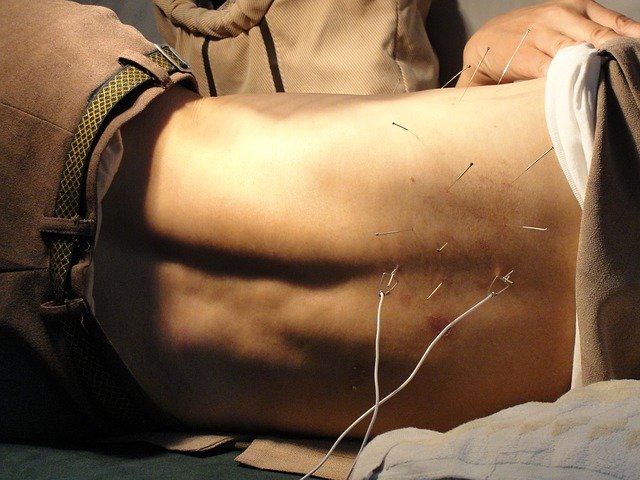
Acupuncture is easily the most visible of all forms of Eastern medicine, but most people in Europe and the United States haven’t tried it.
If you’re interested in the kinds of benefits you can receive from this two thousand-year-old treatment, you should schedule an appointment with a local acupuncturist. Here’s a guide to understanding what you can expect during your first acupuncture treatment.
Acupuncture has been practiced for more than two thousand years, and boasts a wide array of scientific backing. This form of Eastern medicine is used around the world as both primary and supplemental treatment for a variety of conditions.
Most people go to an acupuncturist to find relaxation or help with a specific complaint. Once you’ve identified why you want to try acupuncture, you’re on the way to getting more out of your visits.
At most clinics, your first acupuncture appointment will last longer than further treatment and any follow-up visits. You will be questioned in ways that may not seem relevant, so be prepared to answer questions about your bowel movements, any menstruation problems, or any back pain.
Usually, acupuncturists will use diagnostic measures of looking at your tongue and taking your pulse to make sure they can provide the best and most specific care for you. Then he or she will describe treatment options and lifestyle changes you might take to improve your condition.
When it comes to communicating with you, most acupuncturists will opt for Western medical terms to avoid confusing you, so you don’t have anything to worry about on that score.
Want to try acupuncture? Book your appointment at AB Acupuncture.
Most acupuncturists will not begin treatment on the first visit, but when you’re ready, there are a few things you should know.
First, most forms of treatment will be fairly light in order to gauge your comfort level and allow your acupuncturist to see how you respond to the needles. Based on your diagnosis, initial treatment will usually involve between three to ten acupuncture points.
Most people’s biggest fear when it comes to acupuncture is the feel of the needles in the skin. However, the feeling is normally mild and in most styles of acupuncture, you will feel almost nothing.
Generally, the needles are only inserted about one to three mm into the body, though deeper on fleshier areas.
There are a lot of resources available on acupuncture, so if you have further questions, consult your acupuncturists or check out books at your local library to learn more about the practice.
We think you’ll be surprised at how much you come to enjoy acupuncture.
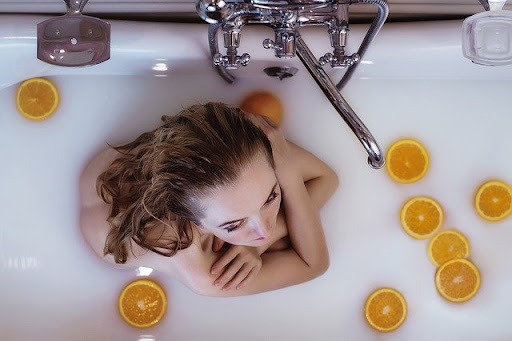
As more and more people are pursuing a natural lifestyle, bath therapy (balneotherapy) is popularized in many parts of the world. While bath therapy is incorporated into Natural Medicine today, it has existed in Chinese culture for thousands of years and been a part of Traditional Chinese Medicine (TCM), called medicated bath or herbal bath. In general, herbal bath can bring the results from cleaning the skin/getting rid of body odor, promoting blood circulation and metabolism, strengthening immune system, to preventing and healing illness.
“The components of an effective herbal bath comprise not only the right ingredient (herb), but also the right water temperature,” TCM Practitioner said. “The liquid is absorbed through the bather’s skin and respiratory system and takes effect by activating the potential life functions in his/her body.”
Today, herbal baths are commonly suggested for conditions such as arthritis, fever, fungus infections, itchiness, pain, skin sores, wounds, and even beauty treatment. And the choice of herbs would be based on individual condition.
In fact, you can try it at your own home. Here are some formulas provided by TCM Practitioner.
If you want to learn more about chinese herbal remedies, visit AB Acupuncture.
Ingredients: Ginger juice (1 ounce / 30 ml), vinegar (0.5 ounce / 15 ml), wine (1.7 ounces / 50 ml)
Method: Pour all ingredients into warm water (around 100 degree Fahrenheit / 38 degree Celsius) and soak for 30 minutes.
Ingredients: [For 10 times use] Pilose asiabell root (1.2 ounces / 35 grams), angelica root (1.2 ounces / 35 grams), safflower (4.2 ounces / 120 grams) and rose (4.2 ounces / 120 grams) Method: Grind all the ingredients into a powder mixture. Pour 1 ounce / 30 grams into warm water (keep the water temperature between 102.2 – 107.6 degree Fahrenheit / 39 – 42 degree Celsius) directly and soak for 20 minutes. Take the bath daily, 10 times as one cycle.
Ingredients: Dried tangerine peel (1.4 ounces / 40 grams); fresh tangerine (4 pieces) Method: Use a gauze bag stuffed with the dried tangerine peels and put into warm water (around 100 degree Fahrenheit / 38 degree Celsius). Cut the fresh tangerines into slices (with skin) and also put into water. Soak for 20 minutes.
Ingredients: Jasmine (0.5 ounce / 15 grams), rose (0.3 ounce / 9 grams), processed poria (0.5 ounce / 15 grams), nutgrass (0.5 ounce / 15 grams).
Method: Grind all the ingredients and pour into warm water (keep the water temperature between 100 – 107.6 degree Fahrenheit / 38 – 42 degree Celsius) directly and soak for 30 minutes. It can calm the mind and smooth the flow of “Qi” (essential energy).
When having herbal bath at home, a rule of thumb is to set the water temperature between 98.6 – 107.6 degree Fahrenheit / 37 – 42 degree Celsius. Steep in the water for not more than half hour while slightly rub the body surface, then rinse the body with clean water. Drink a glass of water to replenish body fluid after a 30-minute rest.
“Herbal baths are easy to use and generally safe. They don’t carry the impacts that oral medicines usually bring to the oral cavity, mucous membrane, digestive canal, and stomach; they also reduce liver’s burden of its detox system. However, they are not suitable for children, the aged, and seriously ill people,” TCM Practitioner noted. “Also, for person who has heart, kidney, or lung problems; or a tendency to bleed easily, he/she should consult a Practitioner first.”
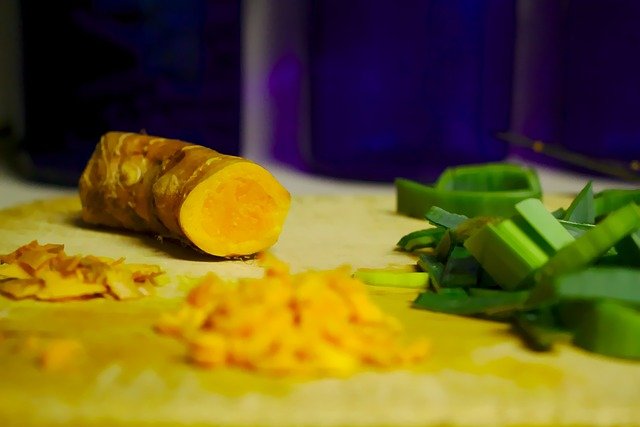
Herbal remedy for yeast infection does not invent today. Actually it has been used for many many years. But in terms of the experience accumulation, theorization, and systematization of herbal applications, Traditional Chinese Medicine (TCM) is offering one of the best home remedies for yeast infections.
Yeast infections, from the point of view of TCM, are mainly related to dampness-heat, toxic and fungus. However, those mentioned elements are just the exterior conditions instead of the main root causes of vaginal yeast infection in women. Traditionally pruritus vulvae is viewed as damp invasion of lower energizer in TCM. These symptoms were also commonly seen in ancient China so that a lot of concrete case records and evidences had been documented by some famous traditional Chinese physician.
TCM believes that the body is a complicated integral system. Any deep hidden diseases will be revealed by other parts of the body. For example, lung is controlling skin and hair. Once something wrong happens to the lung and it can be detected by skin and hair. The spleen is nourishing the muscles and mouth is its exit. If spleen falls ill and fails to fulfill its job, then the muscles and mouth will suffer as well. In other words, any symptom is not the isolated presence and it is always related to other changes in the body. The whole TCM theory is not invented by just a whim from somebody. Instead, it takes thousands of years of observation and finally come to the conclusion now.
Vaginal yeast infection treatment with TCM starts from the whole concept and exploits different approaches to get rid of the root causes according to the diagnosis result. These methods include eliminating dampness and heat, invigorating the spleen for eliminating dampness, tonifying the liver and kidney, soothing liver and strengthening spleen and so on, accompanied with killing parasites to relieve itching. What’s more, the combination of both exterior and interior therapies will receive a better clinical efficacy in most cases.
For those recurring yeast infections, which are often seen in many pregnant women, cancer patients, or other patients in a delicate condition, enhancing their resistance to the outer attacks is the priority. Get at the root of a problem is the most important link in preventing from recurrence. Through taking internal herbal medicine and external treatment, treat both the incidental and fundamental aspects, which is the key to effect a permanent cure.
In yeast infection remedy with TCM, some herbs are being used very frequently. For internal herbal medicine, Long Dan Xie Gan Wan is one of popular formulas. For single herb, the list is as follows:
• Sophora Root (Ku Shen) acts to clear heat, eliminate dampness and kill parasites;
• Cortex Phellodendri (Huang Bai) acts to clear heat, eliminate dampness, detoxify and heal skin lesions;
• Dandelion (Pu Gong Ying) acts to clear heat, detoxify, reduce swelling and remove stasis;
• Radix Stemonae (Bai Bu) acts to sterilize and kill parasites;
• Broom Cypress or Kochia Fruit (Di Fu Zi) acts to clear heat, eliminate dampness, dispel the wind and relieve itching;
• Cnidium monnieri seed (She Chuang Zi) and Dictamnus Root Bark (Bai Xian Pi) act to clear heat, eliminate dampness, dispel the wind and detoxify;
• Pericarpium Zanthoxyli Bungeani (Hua Jiao) acts to kill parasites and relieve itching;
• Dried Alum (Gu Fan) acts to eliminate dampness and astringent.
• Honeysuckle Flower or Lonicera (Jin Yin Hua) and Herba cum Rd Violae Yedoensitis (Zi Hua Di Ding) act to clear heat, detoxify, cool blood heat and reduce swelling;
• Coptis chinensis (Huang Lian) acts to clear heat, eliminate dampness, discharging fire and detoxify;
• Radix Sanguisorbae (Di Yu) acts to clear heat, detoxify, reduce swelling, relieve the pain, cool blood heat, stop bleeding, astringent and promote tissue regeneration.
Of course, the list is not ending here in natural treatment for yeast infection with TCM. However, please note that TCM remedies are not the simple combination of all the mentioned herbs. It needs to come up with the targeting formula to achieve the yeast infection cure. Putting these mentioned herbs together randomly is not a formula at all. So, if you have any doubt about these herbs, contacting an experienced traditional Chinese physician and ask for the pertinent opinion is highly recommended.
Acupuncture is another treatment that helps relieve pain from yeast infection. Book an appointment at AB Acupuncture to know more.
Note: The perineum should be kept clean and underwear should be washed on daily basis. Avoid hand scratch the infected part during herbal remedy for yeast infection.
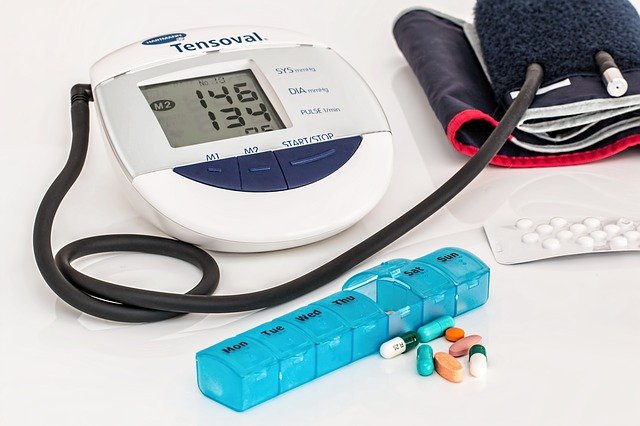
Western medicine defines high blood pressure according to the number measured, which has nothing to do with syndrome differentiation. The high blood pressure treatment by Traditional Chinese Medicine (TCM), however, is based on comprehensive analysis of data gained by four diagnostic methods, including inspection, listening and smelling, inquiry and palpation and pulse taking. What’s more, TCM uses holistic view as guide to get to know the disease, determine etiologic factors based on differentiation and identify the nature or cause through the phenomenon.
High blood pressure is the reaction of fighting disease and body adjustment to resolve the stagnation of qi and blood circulation. From the perspective of Traditional Chinese Medicine, high blood pressure can not be treated at all; instead it can be guided to improve the condition. Regulating our body imbalance based on the holistic view can be the best solution in treating high blood pressure. No precision device and costly medicine needed at all. Thousands of years ago, our ancestors had already showed us how our body works to treat high blood pressure. These theories include Zang-fu Viscera and Channels, Eight Extraordinary Meridians and Midnight-Noon Cycle of Qi. It is marvel that our ancestors can come up with high blood pressure treatment without the help of precision devices. But it is true and it is more realistic and practicable to human body.
Syndrome differentiation of eight principles, Yin and yang, cold and heat are the basic principles of Traditional Chinese Medicine (TCM) in high blood pressure treatment. Treatment aiming at its root causes is always the priority in any diagnosis. Hot limbs, which are far away from the heart, tend to indicate that no blood stasis exists in our body. Cold limbs, on the other hand, tend to indicate that the cold in our body is making blood stasis. And deficiency of Kidney yang is just the cause of inner cold produces. The power of heart comes from kidney. If kidney yang is sufficient enough to supply, all functions will resume working properly. Then heart jumps vigorously, blood stasis resolves and all signs and symptoms of high blood pressure would disappear afterwards.
In TCM practice of high blood treatment, it only focuses on the signs and symptoms, rather than the blood pressure read by the meter. The symptoms include dizziness, numb limbs, cool limbs, stiff neck, headache, humming ears and angina etc. The blood pressure is relatively higher if it measures when those symptoms occur. But from the perspective of Traditional Chinese Medicine (TCM), these symptoms reflect that the yin-yang imbalance of corresponding parts, usually representing that deficiency of qi and blood. Based on the theory, high blood pressure can not be seen as the pathologic subject to be destroyed and the subject to be treated. What we should do is to follow its trend and guide it to work properly to finish the process of fighting disease. Fu zi (aconite root) is, of huge heat nature, a good medicine to warm fire and assists yang. The cold of blood stasis just thaws out like ice when it encounters the fire of Fu zi. Fu zi not only clears all the arterial blood stasis, but also prevents the body from making blood stasis again. Given that this therapy works not only as temporary solution, but also a permanent cure, warming kidney and assisting yang combining with replenishing blood and resolving dampness should be the basic solution in treating cardiovascular and cerebrovascular diseases. It is worth to note that blood pressure would be a little higher, even headache occurs during the therapy. But don’t be afraid of the number read by blood pressure meter. What we should do is insisting therapy till kidney yang restores and blood stasis resolves. Then the blood pressure would be down to normal afterwards.
High blood pressure can also be lowered by acupuncture treatment. To know more about this, visit AB Acupuncture.
What hypotensor do is to restrain central nervous system and weaken the heart function. The decrease of pump pressure seems that it brings down the blood pressure. But decreased blood pressure renders that vessels and tissues at the end of arteries are lack of blood nourishment over a long period of time. Cold limbs can justify it. Due to the shortness of blood supply, capillary vessels become crisp and clogged. When sufferer is stimulated, heart beat would speed up and blood pressure rise abruptly. The capillary vessels, which lack of elasticity due to shortness of blood nourishment, would rupture and then stroke occur. That is the reason why the number of stroke patients increase year by year and why it becomes the second killer. A few lucky persons were saved, but they are disabled ever since.
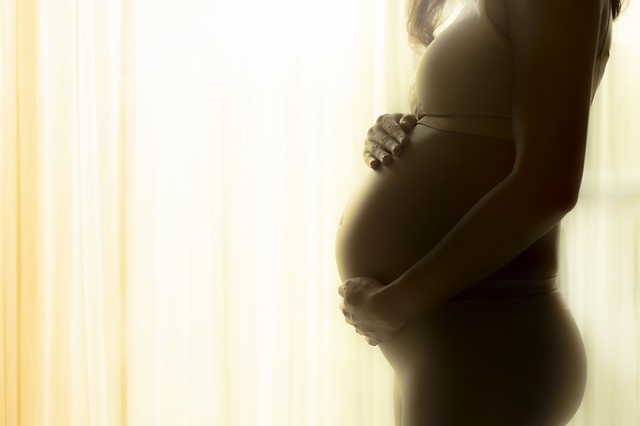
The using of fertility herbs for women has a long history in China. In ancient time or even in modern China, to carry on the family line is still the top most priority for a married woman. If a woman, for some reason, is unable to have a baby, she has very little status in her family no matter it is because her or her husband. Given that mentioned reason, the research on herbs for infertility has always gained great attention in China.
Now more and more strong evidence was added by modern research to support the efficacy of natural fertility herbs. And the studies from western counterparts also revealed that Chinese herbs for fertility like Dong Quai, Vitex and black cohosh could help bring relief to menopausal symptoms and premenstrual syndrome. And they also considered that fertility herb may increase fertility naturally by involving in regulating the female endocrine.
If a woman has nothing wrong with physical condition, western medical system tends to give the diagnosis as “unexplained infertility” after the fertility tests for women. However, from the point of view of Traditional Chinese medicine (TCM), any unusual conditions can trace the root causes why it occurred and use the facts to develop a remedy except her was born with it.
TCM also believes that the causes for female infertility come from many aspects. The following are those main causes. These causes, more or less, are all connected with the imbalance in visceral organ of kidney, liver and spleen.
• The first main cause is congenital deficiency of kidney Qi or acquired deficiency due to excess of sex life;
• The second main cause is recurrent miscarriage, which may also damage the kidney function and lead to deficiency of kidney Qi;
• The third main cause is depression in a long period. It can result in stagnancy of Liver Qi, which would finally lead to female infertility too. Long ago ancient Chinese had come to realize that moody was closely related to many diseases. This cause is also known as “Jealousness Infertility”.
• The fourth main cause is binge. Drinking too much wine and eating too much oily food can generate a substantial amount of phlegm inside the body, which might contribute to female infertility. In such case, it is also known as “Obesity Infertility”.
Of course the causes for infertility in TCM don’t end here. But the above-mentioned four types are most common seen. As for causes for men, please refer to another article of male infertility causes.
Today in drug store, you can easily find some ready-made TCM fertility drugs for women such as Wu Zi Yan Zong Wan and Tiao Jing Cu Yun Wan. So here comes in the question – which Chinese fertility herbs should be taken to increase fertility naturally in women? At this moment I have to repeat it again that normally any diagnosis by Chinese medicine needs to perform the four diagnostic methods, namely inspection, listening and smelling, inquiry, pulse taking and palpation, before giving out any description. If possible, please consult a TCM doctor before taking these natural fertility pills, fertility vitamins or fertility supplements.
Regularly some herbs can be always found in the some formulas, which are used for infertility treatment in women. These infertility herbs are believed to tonify kidney and thus increase fertility in women. The list is as follows.
• Tu Si Zi (Semen Cuscutae Chinensis);
• Nu Zhen Zi (Fructus Ligustri Lucidi);
• Du Zhong (Ecommia Bark);
• Gou Ji Zi (Chinese Wolfberry);
• Yin Yang Huo (Arial Parts of Epimedium);
• Ba Ji Tian (Morinda Root);
• Shu Di Huang (Rehmannia, Chinese Foxglove Root).
Actually infertility treatments with TCM does not end just Chinese fertility herbs. In fact acupuncture is another popular way available today. For more information about it, please visit AB Acupuncture.
One thing need to stress in natural fertility treatments is that there are many other causes involved in female infertility, which include retroversion of uterus, cervicitis or salpingitis, oophoritis, endometriosis, uterine fibroids and polycystic ovarian syndrome and so on. All these mentioned diseases can impair women’s fertility. In addition, lifestyle factors such as drinking, smoking, malnutrition, stress and emotional reasons are also the aspects that need to pay attention to.
On the contrary, for most women, they have to change their bad lifestyle in the first place. Otherwise, TCM can do nothing to help either. Nevertheless, if there are other problems such as stress, infection, and inflammation, the TCM doctor will also prescribe the corresponding fertility herbs for women to effect a cure.